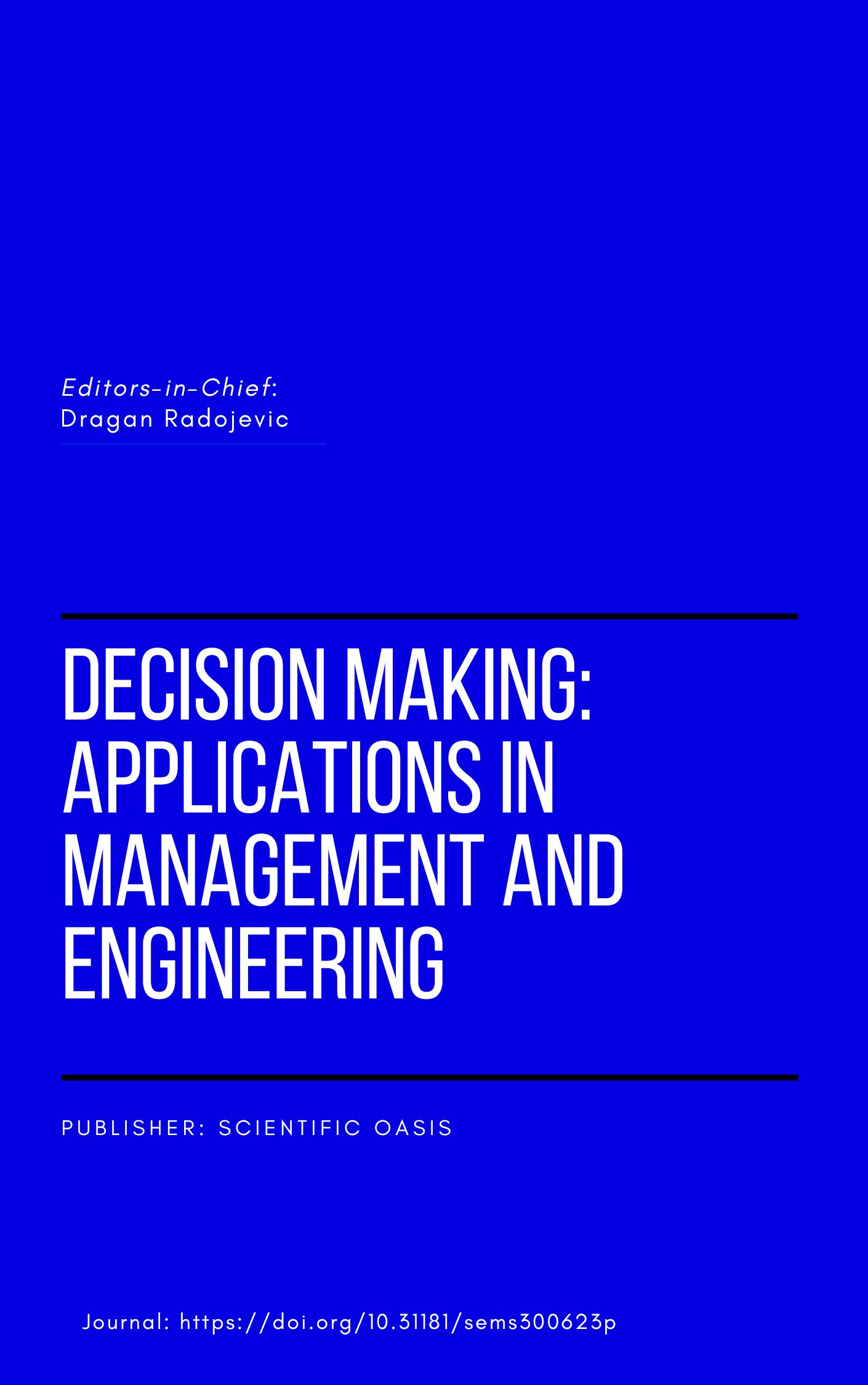A Structural Equation Decision Model for ATM Cash Management and Routing: Balancing Cost and Customer Satisfaction in the Banking Sector
DOI:
https://doi.org/10.31181/dmame8120251468Keywords:
ATM Cash Management, Operational Efficiency, Customer Satisfaction, Technological Readiness, Managerial Competence, PLS-SEMAbstract
This research explores the factors influencing ATM cash management and routing efficiency within the Palestinian banking industry, employing responses from 500 banking personnel and analysing the data using Partial Least Squares Structural Equation Modelling (PLS-SEM). The conceptual framework incorporates managerial competence, technological readiness, and both regulatory and environmental support as antecedents of operational performance and customer satisfaction. The findings indicate that these organisational elements significantly contribute to enhanced operational performance, which subsequently acts as a mediator in improving customer satisfaction. While cost management effectiveness does not exert a direct influence on satisfaction, it slightly moderates and strengthens the association between operational performance and satisfaction. This study contributes to the literature by integrating behavioural insights with operational outcomes and offers practical guidance for financial institutions and regulatory bodies aiming to enhance ATM-related services and customer value in developing economies.
Downloads
References
[1] Ahmed, R. R., Streimikiene, D., Channar, Z. A., Soomro, R. H., & Streimikis, J. (2021). E-banking customer satisfaction and loyalty: Evidence from serial mediation through modified ES-QUAL model and second-order PLS-SEM. Engineering Economics, 32(5), 407-421. https://doi.org/10.5755/j01.ee.32.5.28997
[2] Andrawis, R. R., Atiya, A. F., & El-Shishiny, H. (2011). Forecast combinations of computational intelligence and linear models for the NN5 time series forecasting competition. International journal of forecasting, 27(3), 672-688. https://doi.org/10.1016/j.ijforecast.2010.09.005
[3] Barlan-Espino, A. G. (2017). Operational efficiency and customer satisfaction of restaurants: Basis for business operation enhancement. Asia Pacific Journal of Multidisciplinary Research, 5(1), 122-132. https://www.academia.edu/41971582/
[4] Batı, Ş., & Gözüpek, D. (2017). Joint optimization of cash management and routing for new-generation automated teller machine networks. IEEE Transactions on Systems, Man, and Cybernetics: Systems, 49(12), 2724-2738. https://doi.org/10.1109/TSMC.2017.2710359
[5] Bitner, M. J. (1990). Evaluating service encounters: the effects of physical surroundings and employee responses. Journal of marketing, 54(2), 69-82. https://doi.org/10.1177/002224299005400206
[6] Brentnall, A. R., Crowder, M. J., & Hand, D. J. (2010). Predicting the amount individuals withdraw at cash machines using a random effects multinomial model. Statistical Modelling, 10(2), 197-214. https://doi.org/10.1177/1471082X0801000205
[7] Brozzi, R., Riedl, M., & Matta, D. (2021). Key readiness indicators to assess the digital level of manufacturing SMEs. Procedia CIRP, 96, 201-206. https://doi.org/10.1016/j.procir.2021.01.075
[8] Castro, J. (2009). A stochastic programming approach to cash management in banking. European Journal of Operational Research, 192(3), 963-974. https://doi.org/10.1016/j.ejor.2007.10.015
[9] Chavez, R., Yu, W., Feng, M., & Wiengarten, F. (2016). The effect of customer‐centric green supply chain management on operational performance and customer satisfaction. Business Strategy and the Environment, 25(3), 205-220. http://dx.doi.org/10.1002/bse.1868
[10] Chin, W. W., Marcolin, B. L., & Newsted, P. R. (2003). A partial least squares latent variable modeling approach for measuring interaction effects: Results from a Monte Carlo simulation study and an electronic-mail emotion/adoption study. Information systems research, 14(2), 189-217. https://doi.org/10.1287/isre.14.2.189.16018
[11] Coyle, J. J., Langley, C. J., Novack, R. A., & Gibson, B. J. (2017). Supply chain management : a logistics perspective (10e ed.). Cengage Learning. https://cir.nii.ac.jp/crid/1130282270893113216
[12] Darwish, S. M. (2013). A methodology to improve cash demand forecasting for ATM network. International journal of Computer and electrical engineering, 5(4), 405-409. http://www.ijcee.org/papers/741-T017.pdf
[13] Diao, Y., Sarkar, R., & Jan, E.-E. (2016). Optimizing ATM cash flow network management. NOMS 2016-2016 IEEE/IFIP Network Operations and Management Symposium, 1073-1078. https://doi.org/10.1109/NOMS.2016.7502963
[14] Ekinci, Y., Serban, N., & Duman, E. (2021). Optimal ATM replenishment policies under demand uncertainty. Operational Research, 21, 999-1029. https://doi.org/10.1007/s12351-019-00466-4
[15] Farooq, M. S., Salam, M., Fayolle, A., Jaafar, N., & Ayupp, K. (2018). Impact of service quality on customer satisfaction in Malaysia airlines: A PLS-SEM approach. Journal of Air Transport Management, 67, 169-180. https://doi.org/10.1016/j.jairtraman.2017.12.008
[16] Fornell, C., & Larcker, D. F. (1981). Evaluating structural equation models with unobservable variables and measurement error. Journal of marketing research, 18(1), 39-50. https://doi.org/10.1177/002224378101800104
[17] Froehle, C. M. (2006). Service personnel, technology, and their interaction in influencing customer satisfaction. Decision Sciences, 37(1), 5-38. https://doi.org/10.1111/j.1540-5414.2006.00108.x
[18] González-Mohíno, M., Donate, M. J., Muñoz-Fernández, G. A., & Cabeza-Ramírez, L. J. (2024). Robotic digitalization and business success: the central role of trust and leadership in operational efficiency. A hybrid approach using PLS-SEM and fsQCA. IEEE Access. https://doi.org/10.1109/ACCESS.2024.3509623
[19] Hair, J. F., Risher, J. J., Sarstedt, M., & Ringle, C. M. (2019). When to use and how to report the results of PLS-SEM. European business review, 31(1), 2-24. https://doi.org/10.1108/EBR-11-2018-0203
[20] Hair, J. F., Sarstedt, M., & Ringle, C. M. (2019). Rethinking some of the rethinking of partial least squares. European journal of marketing, 53(4), 566-584. https://doi.org/10.1108/EJM-10-2018-0665
[21] Hamzah, A. A., & Shamsudin, M. F. (2020). Why customer satisfaction is important to business? Journal of Undergraduate Social Science and Technology, 1(1). http://abrn.asia/ojs/index.php/JUSST/article/view/58
[22] Henseler, J., Ringle, C. M., & Sarstedt, M. (2015). A new criterion for assessing discriminant validity in variance-based structural equation modeling. Journal of the academy of marketing science, 43, 115-135. https://doi.org/10.1007/s11747-014-0403-8
[23] Isiaku, L., & Adalier, A. (2025). Investigating the determinants of continuous use intention of business intelligence systems in Nigerian banks: the role of regulatory support. Management Decision. https://doi.org/10.1108/MD-08-2024-1848
[24] Karimi, N., & Davoudpour, H. (2017). Integrated production and delivery scheduling for multi-factory supply chain with stage-dependent inventory holding cost. Computational and Applied Mathematics, 36, 1529-1544. https://doi.org/10.1007/s40314-016-0305-0
[25] Khan, S., & Abdullah, N. N. (2019). The effect of ATM service quality on customer’s satisfaction and loyalty: an empirical analysis. Russian Journal of Agricultural and Socio-Economic Sciences, 89(5), 227-235. https://cyberleninka.ru/article/n/the-effect-of-atm-service-quality-on-customer-s-satisfaction-and-loyalty-an-empirical-analysis
[26] Khudzari, F., Haron, A. T., Ayer, S. K., & Rahman, R. A. (2025). Transformative trajectories: PLS-SEM analysis of factors influencing emerging technologies in construction adoption in Malaysia. Journal of Information Technology in Construction (ITcon), 30(3), 45-64. https://dx.doi.org/10.36680/j.itcon.2025.003
[27] Kline, R. B. (2012). Assumptions in structural equation modeling. Handbook of structural equation modeling, 111, 125. https://psycnet.apa.org/record/2012-16551-007
[28] Kroes, J., Subramanian, R., & Subramanyam, R. (2012). Operational compliance levers, environmental performance, and firm performance under cap and trade regulation. Manufacturing & Service Operations Management, 14(2), 186-201. https://doi.org/10.1287/msom.1110.0357
[29] Le, A. T. H., & Sutrisna, M. (2024). Project cost control system and enabling-factors model: PLS-SEM approach and importance-performance map analysis. Engineering, Construction and Architectural Management, 31(6), 2513-2535. https://doi.org/10.1108/ECAM-07-2022-0619
[30] Lee, S. E., & Shin, G. (2023). The effect of perceived organizational and supervisory support on employee engagement during COVID-19 crises: Mediating effect of work-life balance policy. Public Personnel Management, 52(3), 401-428. https://doi.org/10.1177/00910260231171395
[31] Love, P. E., Sing, C.-P., Wang, X., Irani, Z., & Thwala, D. W. (2014). Overruns in transportation infrastructure projects. Structure and Infrastructure Engineering, 10(2), 141-159. https://doi.org/10.1080/15732479.2012.715173
[32] Mainardes, E. W., & Freitas, N. P. d. (2023). The effects of perceived value dimensions on customer satisfaction and loyalty: a comparison between traditional banks and fintechs. International Journal of Bank Marketing, 41(3), 641-662. https://doi.org/10.1108/IJBM-10-2022-0437
[33] Manutworakit, P., & Choocharukul, K. (2022). Factors influencing battery electric vehicle adoption in Thailand—Expanding the unified theory of acceptance and use of technology’s variables. Sustainability, 14(14), 8482. https://doi.org/10.3390/su14148482
[34] Mezhuyev, V., Tschandl, M., & Brandstatter, C. (2022). Model of effective cost management in the time of corona crisis: a PLS-SEM approach. Proceedings of the 2022 8th International Conference on Computer Technology Applications, 11-15. https://doi.org/10.1145/3543712.3543753
[35] Migdad, A. M. (2017). CSR practices of Palestinian Islamic banks: contribution to socio-economic development. ISRA International Journal of Islamic Finance, 9(2), 133-147. https://doi.org/10.1108/IJIF-06-2017-0001
[36] Motamarri, S., Akter, S., Hossain, M. A., & Dwivedi, Y. K. (2022). How does remote analytics empowerment capability payoff in the emerging industrial revolution? Journal of Business Research, 144, 1163-1174. https://doi.org/10.1016/j.jbusres.2022.02.064
[37] Mwatsika, C. (2016). Factors influencing customer satisfaction with ATM banking. International Journal of Academic Research in Business and Social Sciences, 6(2), 26-41. http://dx.doi.org/10.6007/IJARBSS/v6-i2/2002
[38] Narteh, B. (2013). Service quality in automated teller machines: an empirical investigation. Managing Service Quality: An International Journal, 23(1), 62-89. https://doi.org/10.1108/09604521311287669
[39] Nguyen, H. Q., Nguyen, Q. H., Tran, P. T., Trinh, N. L., & Nguyen, Q. T. (2023). The relationship between service quality of banking kiosk and customer satisfaction: the moderating role of technology readiness. International Journal of Quality and Service Sciences, 15(3/4), 273-290. https://doi.org/10.1108/IJQSS-01-2023-0004
[40] Pandey, A., Jayarathne, P., Yadav, A. K., & Chandel, A. (2025). Role of Innovation and Entrepreneurship in Economic Diversification. In Entrepreneurial Ecosystems Driving Economic Transformation and Job Creation (pp. 57-92). IGI Global Scientific Publishing. http://doi.org/10.4018/979-8-3693-9486-1.ch003
[41] Panigrahi, R. R., Jena, D., Meher, J. R., & Shrivastava, A. K. (2023). Assessing the impact of supply chain agility on operational performances-a PLS-SEM approach. Measuring Business Excellence, 27(1), 1-24. https://doi.org/10.1108/MBE-06-2021-0073
[42] Parasuraman, A., & Colby, C. L. (2015). An updated and streamlined technology readiness index: TRI 2.0. Journal of service research, 18(1), 59-74. https://doi.org/10.1177/1094670514539730
[43] Radwan, B. Q., Romli, N., & Awang, M. (2021). The Impact of Customer Management Models, Organizational Readiness, and Personal Capabilities on Non-financial Performance of Computer Technology Companies in Dubai. Turkish Journal of Computer and Mathematics Education, 12(11), 6416-6430. https://www.proquest.com/openview/3c783f5a8841427adc2ce8b8752c978a/1?pq-origsite=gscholar&cbl=2045096
[44] Rafi, M., Wahab, M. T., Khan, M. B., & Raza, H. (2021). Towards optimal ATM cash replenishment using time series analysis. Journal of Intelligent & Fuzzy Systems, 41(6), 5915-5927. https://doi.org/10.3233/JIFS-201953
[45] Rajwani, A., Syed, T., Khan, B., & Behlim, S. (2017). Regression analysis for ATM cash flow prediction. 2017 International Conference on Frontiers of Information Technology (FIT), 1538635674. https://doi.org/10.1109/FIT.2017.00045
[46] Reyes-Mercado, P. (2023). A Narrative Review of Research on the Sustainable Development Goals in the Business Discipline. Paradigm Shift in Business: Critical Appraisal of Agile Management Practices, 361-379. https://doi.org/10.1007/978-3-031-40439-9_18
[47] Schnitzler, C., & Bohnet-Joschko, S. (2025). Technology Readiness Drives Digital Adoption in Dentistry: Insights from a Cross-Sectional Study. Healthcare, 2227-9032. https://doi.org/10.3390/healthcare13101155
[48] Simutis, R., Dilijonas, D., Bastina, L., Friman, J., & Drobinov, P. (2007). Optimization of cash management for ATM network. Information technology and control, 36(1). https://www.itc.ktu.lt/index.php/ITC/article/view/11829
[49] Sivarajah, U., Kamal, M. M., Irani, Z., & Weerakkody, V. (2017). Critical analysis of Big Data challenges and analytical methods. Journal of Business Research, 70, 263-286. https://doi.org/10.1016/j.jbusres.2016.08.001
[50] Sriboonlue, U., CHAIPRASIT, K., & Onputtha, S. (2024). Enhancing Operational Efficiency: Investigating Technology Readiness, Acceptance, and Utilization of Thailand National Single Window in Import, Export, and Logistics Businesses. Asian Administration & Management Review, 7(2). https://ssrn.com/abstract=4874287
[51] Sualeh Khattak, M., Wu, Q., Ahmad, M., & Ullah, R. (2024). The role of managerial competencies in managing resources for sustainable development strategy in SMEs. Social Responsibility Journal, 20(7), 1317-1344. https://doi.org/10.1108/SRJ-11-2023-0634
[52] Tarasi, C. O., Bolton, R. N., Gustafsson, A., & Walker, B. A. (2013). Relationship characteristics and cash flow variability: Implications for satisfaction, loyalty, and customer portfolio management. Journal of service research, 16(2), 121-137. https://doi.org/10.1177/1094670512465958
[53] Thanh, B. T., Van Tuan, D., Chi, T. A., Van Dai, N., Dinh, N. T. Q., Thuy, N. T., & Hoa, N. T. X. (2023). Multiobjective Logistics Optimization for Automated ATM Cash Replenishment Process. International Conference on Intelligence of Things, 46-56. https://doi.org/10.1007/978-3-031-46573-4_5
[54] Yahaya, R., & Segbenya, M. (2023). Modelling the influence of managerial competence on managerial performance in the Ghanaian banking sector. Humanities and social sciences communications, 10(1), 1-11. https://doi.org/10.1057/s41599-023-02384-5
[55] Yang, F., & Tao, F. (2023). A bi-objective optimization VRP model for cold chain logistics: Enhancing cost efficiency and customer satisfaction. IEEE Access, 11, 127043-127056. https://doi.org/10.1109/ACCESS.2023.3332145
[56] Yu, W., Chavez, R., Feng, M., & Wiengarten, F. (2014). Integrated green supply chain management and operational performance. Supply Chain Management: An International Journal, 19(5/6), 683-696. https://doi.org/10.1108/SCM-07-2013-0225
[57] Zıdan, K. (2019). The impact of banking sector on economic growth: Empirical analysis from Palestinian economy. International Journal of Economics and Financial Issues, 9(1), 1-6. https://doi.org/10.32479/ijefi.7369
Downloads
Published
How to Cite
Issue
Section
License
Copyright (c) 2025 Decision Making: Applications in Management and Engineering

This work is licensed under a Creative Commons Attribution 4.0 International License.












